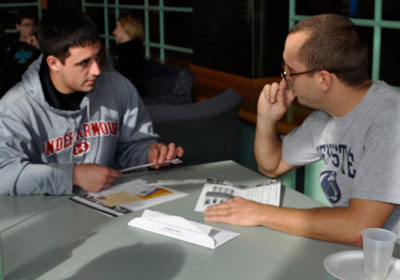In a heartwarming effort to honor beloved professor Arnold Markley, who will soon undergo a bone marrow transplant to win his fight against leukemia, nearly 70 people, more than half of them students, joined the national marrow donor registry on Friday, Dec. 4 at Penn State Brandywine's "Be The Match Registry" drive.
"I was inspired to [join the registry] after hearing about Dr. Markley," 19-year-old freshman Will Schmidt, of West Chester, said. "Registering only took about 10 minutes and I figured that if I turn out to be a match, I will gladly take a day off work to save someone's life."
Patricia Hillen, a good friend of Markley's and one of the organizers of the event, was beyond grateful for all the support from the community during the drive. "It was so heartening to see our campus come together in such a big way at the donor drive," the instructor in English said. "People were very generous with both their time and their money. I was especially touched to see my own students there, smiling and swabbing their cheeks. Even one of our alums, Paul Rementer, now a sales rep with Wawa, stopped in to join the registry. He saw that we were in need of some coffee and made the phone call. Voila! There was coffee. It was a privilege to be a part of something so wonderful and in honor of my good friend, Arnold Markley."
The many myths surrounding bone marrow donation often cloud the importance of its purpose: to save a life. But one myth stands out in the crowd, and was a concern of many students: bone marrow donation is painful. Not true, say the folks at the National Marrow Donor Program. "Donors feel no needle injections and no pain during the marrow donation process," according to marrow.org. "Afterwards, most donors feel some pain in the lower back for a few days or longer."
Eighteen-year-old Joel Idicula, also a freshman, of Broomall, ignored the myth and joined the registry. "I was inspired to donate because of the fact that it is a simple procedure on my part that can save someone's life," he said. "I thought of the families of the people who could get [the marrow donation] and that was enough." But this young student's courage is worth more than he thinks. Idicula is Indian and the registry is significantly lacking donors from diverse racial and ethnic backgrounds.

Freshman Johnny Neel, of Landenberg, receives instruction on how to swab his cheek with a Q-tip as he joins the bone marrow donor registry during Penn State Brandywine's "Be The Match Registry" drive on Dec. 4, held in an effort to save lives by helping to build the national registry.
With more than seven million people in the donor registry, thousands of patients still are unable to find a match because more than 70 percent of potential donors are Caucasian, and race and ethnicity matter in terms of finding a perfect match for a patient in need. "Because the markers used in matching are inherited, patients are more likely to match someone from their own race or ethnicity," according to the site.
All it takes to join the registry is a saliva sample from adults, ages 18 through 60, who meet health guidelines and are willing to donate to any patient in need. Marrow is not extracted during the test, as other myths imply.
But fellow organizer and friend of Markley, Gail Wray, stressed the importance of the commitment that comes with becoming a donor. "Joining the registry is a commitment not to be taken lightly. If you are a match, you can save a patient's life. That patient is somebody's sister or child, uncle or parent, and is counting on your sacrifice."